Corporate Finance Case Study: Ford Motor Company's VEP Analysis
VerifiedAdded on 2023/06/11
|13
|4047
|167
Case Study
AI Summary
This case study solution analyzes Ford Motor Company's Value Enhancement Plan (VEP), examining whether Ford should proceed with the complicated VEP, issue a cash dividend, or conduct a share repurchase. It evaluates the implications of the VEP for different shareholders, including Ford family members, institutional investors, and regular shareholders, recommending optimal choices for each group based on their specific interests and the potential impact on voting rights and returns. The analysis includes a discussion of the company's dividend policy and the potential for share buybacks to improve market position. Additionally, the solution involves calculating the Weighted Average Cost of Capital (WACC) for Ford, DaimlerChrysler, and General Motors in 1999, using beta information and balance sheet data to justify the calculations and provide a comprehensive financial assessment of Ford's strategic options.
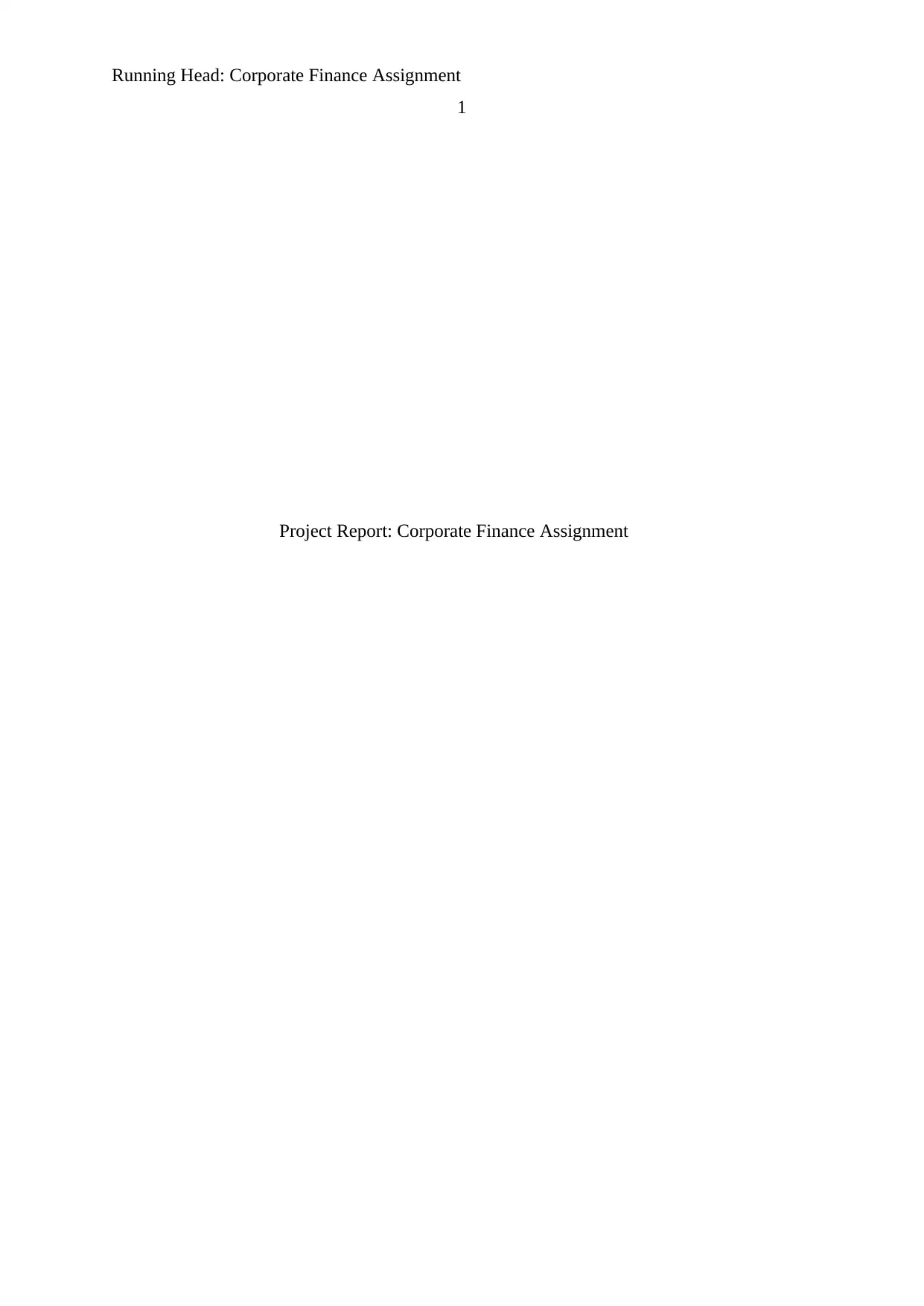
Running Head: Corporate Finance Assignment
1
Project Report: Corporate Finance Assignment
1
Project Report: Corporate Finance Assignment
Paraphrase This Document
Need a fresh take? Get an instant paraphrase of this document with our AI Paraphraser
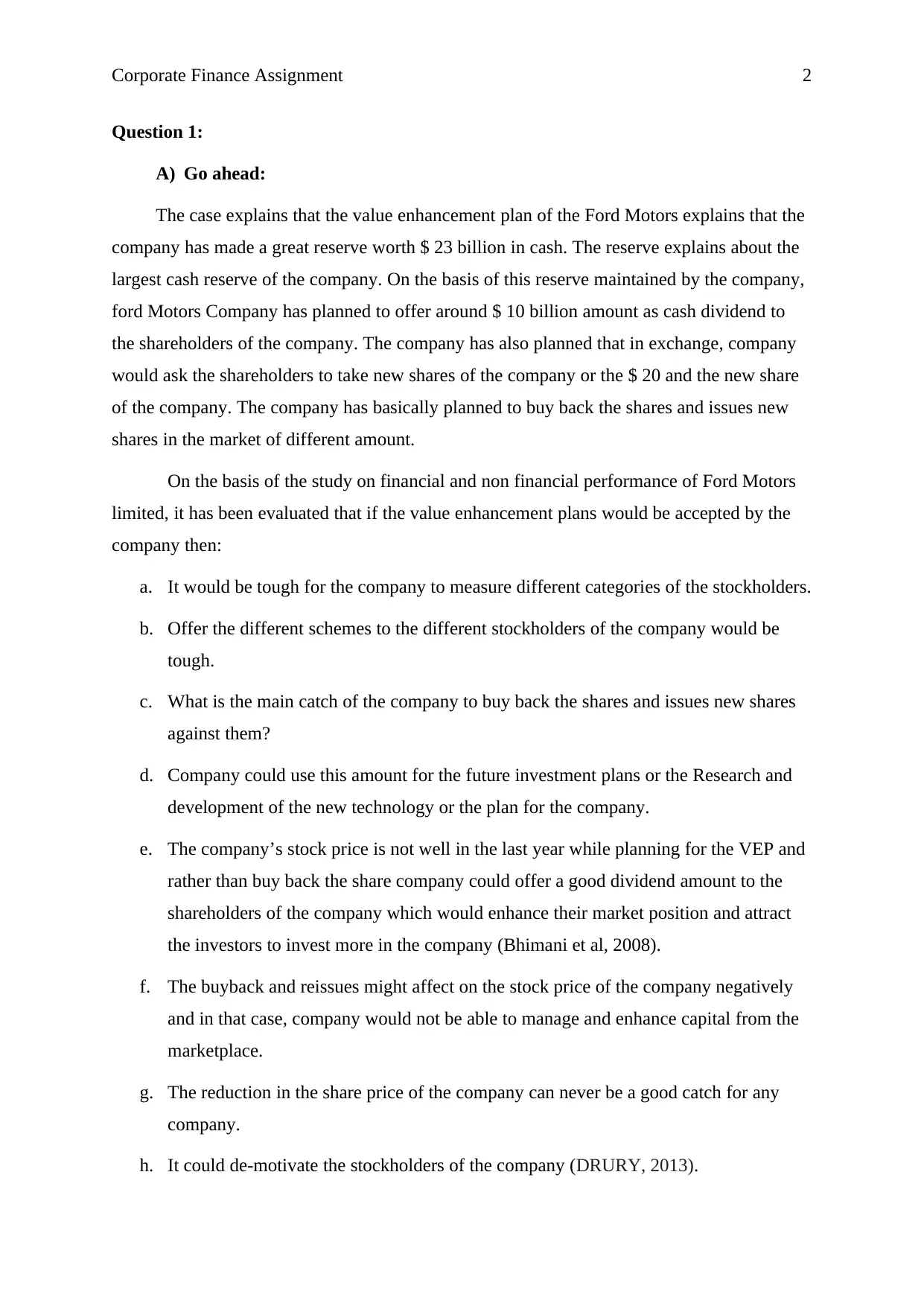
Corporate Finance Assignment 2
Question 1:
A) Go ahead:
The case explains that the value enhancement plan of the Ford Motors explains that the
company has made a great reserve worth $ 23 billion in cash. The reserve explains about the
largest cash reserve of the company. On the basis of this reserve maintained by the company,
ford Motors Company has planned to offer around $ 10 billion amount as cash dividend to
the shareholders of the company. The company has also planned that in exchange, company
would ask the shareholders to take new shares of the company or the $ 20 and the new share
of the company. The company has basically planned to buy back the shares and issues new
shares in the market of different amount.
On the basis of the study on financial and non financial performance of Ford Motors
limited, it has been evaluated that if the value enhancement plans would be accepted by the
company then:
a. It would be tough for the company to measure different categories of the stockholders.
b. Offer the different schemes to the different stockholders of the company would be
tough.
c. What is the main catch of the company to buy back the shares and issues new shares
against them?
d. Company could use this amount for the future investment plans or the Research and
development of the new technology or the plan for the company.
e. The company’s stock price is not well in the last year while planning for the VEP and
rather than buy back the share company could offer a good dividend amount to the
shareholders of the company which would enhance their market position and attract
the investors to invest more in the company (Bhimani et al, 2008).
f. The buyback and reissues might affect on the stock price of the company negatively
and in that case, company would not be able to manage and enhance capital from the
marketplace.
g. The reduction in the share price of the company can never be a good catch for any
company.
h. It could de-motivate the stockholders of the company (DRURY, 2013).
Question 1:
A) Go ahead:
The case explains that the value enhancement plan of the Ford Motors explains that the
company has made a great reserve worth $ 23 billion in cash. The reserve explains about the
largest cash reserve of the company. On the basis of this reserve maintained by the company,
ford Motors Company has planned to offer around $ 10 billion amount as cash dividend to
the shareholders of the company. The company has also planned that in exchange, company
would ask the shareholders to take new shares of the company or the $ 20 and the new share
of the company. The company has basically planned to buy back the shares and issues new
shares in the market of different amount.
On the basis of the study on financial and non financial performance of Ford Motors
limited, it has been evaluated that if the value enhancement plans would be accepted by the
company then:
a. It would be tough for the company to measure different categories of the stockholders.
b. Offer the different schemes to the different stockholders of the company would be
tough.
c. What is the main catch of the company to buy back the shares and issues new shares
against them?
d. Company could use this amount for the future investment plans or the Research and
development of the new technology or the plan for the company.
e. The company’s stock price is not well in the last year while planning for the VEP and
rather than buy back the share company could offer a good dividend amount to the
shareholders of the company which would enhance their market position and attract
the investors to invest more in the company (Bhimani et al, 2008).
f. The buyback and reissues might affect on the stock price of the company negatively
and in that case, company would not be able to manage and enhance capital from the
marketplace.
g. The reduction in the share price of the company can never be a good catch for any
company.
h. It could de-motivate the stockholders of the company (DRURY, 2013).
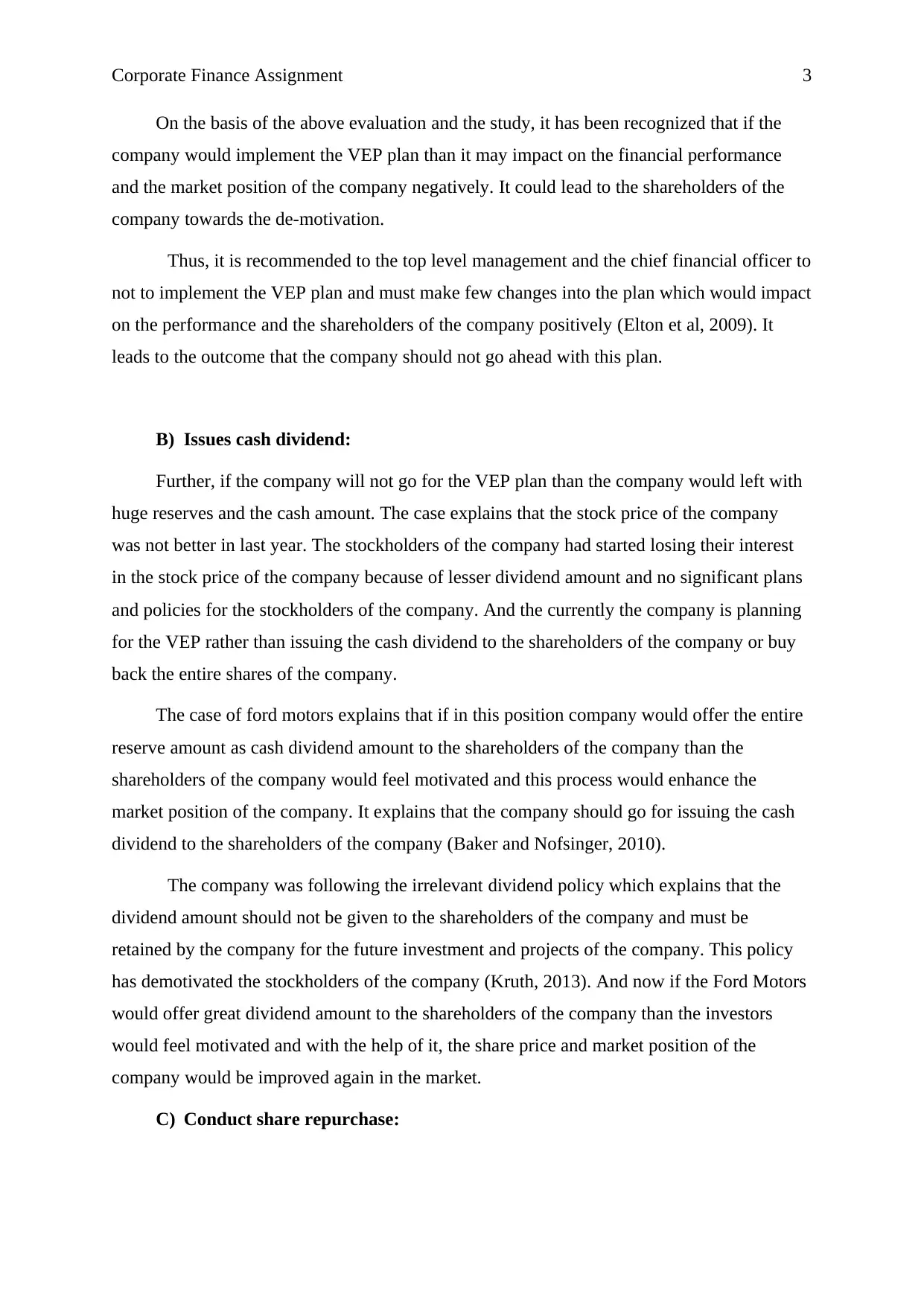
Corporate Finance Assignment 3
On the basis of the above evaluation and the study, it has been recognized that if the
company would implement the VEP plan than it may impact on the financial performance
and the market position of the company negatively. It could lead to the shareholders of the
company towards the de-motivation.
Thus, it is recommended to the top level management and the chief financial officer to
not to implement the VEP plan and must make few changes into the plan which would impact
on the performance and the shareholders of the company positively (Elton et al, 2009). It
leads to the outcome that the company should not go ahead with this plan.
B) Issues cash dividend:
Further, if the company will not go for the VEP plan than the company would left with
huge reserves and the cash amount. The case explains that the stock price of the company
was not better in last year. The stockholders of the company had started losing their interest
in the stock price of the company because of lesser dividend amount and no significant plans
and policies for the stockholders of the company. And the currently the company is planning
for the VEP rather than issuing the cash dividend to the shareholders of the company or buy
back the entire shares of the company.
The case of ford motors explains that if in this position company would offer the entire
reserve amount as cash dividend amount to the shareholders of the company than the
shareholders of the company would feel motivated and this process would enhance the
market position of the company. It explains that the company should go for issuing the cash
dividend to the shareholders of the company (Baker and Nofsinger, 2010).
The company was following the irrelevant dividend policy which explains that the
dividend amount should not be given to the shareholders of the company and must be
retained by the company for the future investment and projects of the company. This policy
has demotivated the stockholders of the company (Kruth, 2013). And now if the Ford Motors
would offer great dividend amount to the shareholders of the company than the investors
would feel motivated and with the help of it, the share price and market position of the
company would be improved again in the market.
C) Conduct share repurchase:
On the basis of the above evaluation and the study, it has been recognized that if the
company would implement the VEP plan than it may impact on the financial performance
and the market position of the company negatively. It could lead to the shareholders of the
company towards the de-motivation.
Thus, it is recommended to the top level management and the chief financial officer to
not to implement the VEP plan and must make few changes into the plan which would impact
on the performance and the shareholders of the company positively (Elton et al, 2009). It
leads to the outcome that the company should not go ahead with this plan.
B) Issues cash dividend:
Further, if the company will not go for the VEP plan than the company would left with
huge reserves and the cash amount. The case explains that the stock price of the company
was not better in last year. The stockholders of the company had started losing their interest
in the stock price of the company because of lesser dividend amount and no significant plans
and policies for the stockholders of the company. And the currently the company is planning
for the VEP rather than issuing the cash dividend to the shareholders of the company or buy
back the entire shares of the company.
The case of ford motors explains that if in this position company would offer the entire
reserve amount as cash dividend amount to the shareholders of the company than the
shareholders of the company would feel motivated and this process would enhance the
market position of the company. It explains that the company should go for issuing the cash
dividend to the shareholders of the company (Baker and Nofsinger, 2010).
The company was following the irrelevant dividend policy which explains that the
dividend amount should not be given to the shareholders of the company and must be
retained by the company for the future investment and projects of the company. This policy
has demotivated the stockholders of the company (Kruth, 2013). And now if the Ford Motors
would offer great dividend amount to the shareholders of the company than the investors
would feel motivated and with the help of it, the share price and market position of the
company would be improved again in the market.
C) Conduct share repurchase:
⊘ This is a preview!⊘
Do you want full access?
Subscribe today to unlock all pages.

Trusted by 1+ million students worldwide
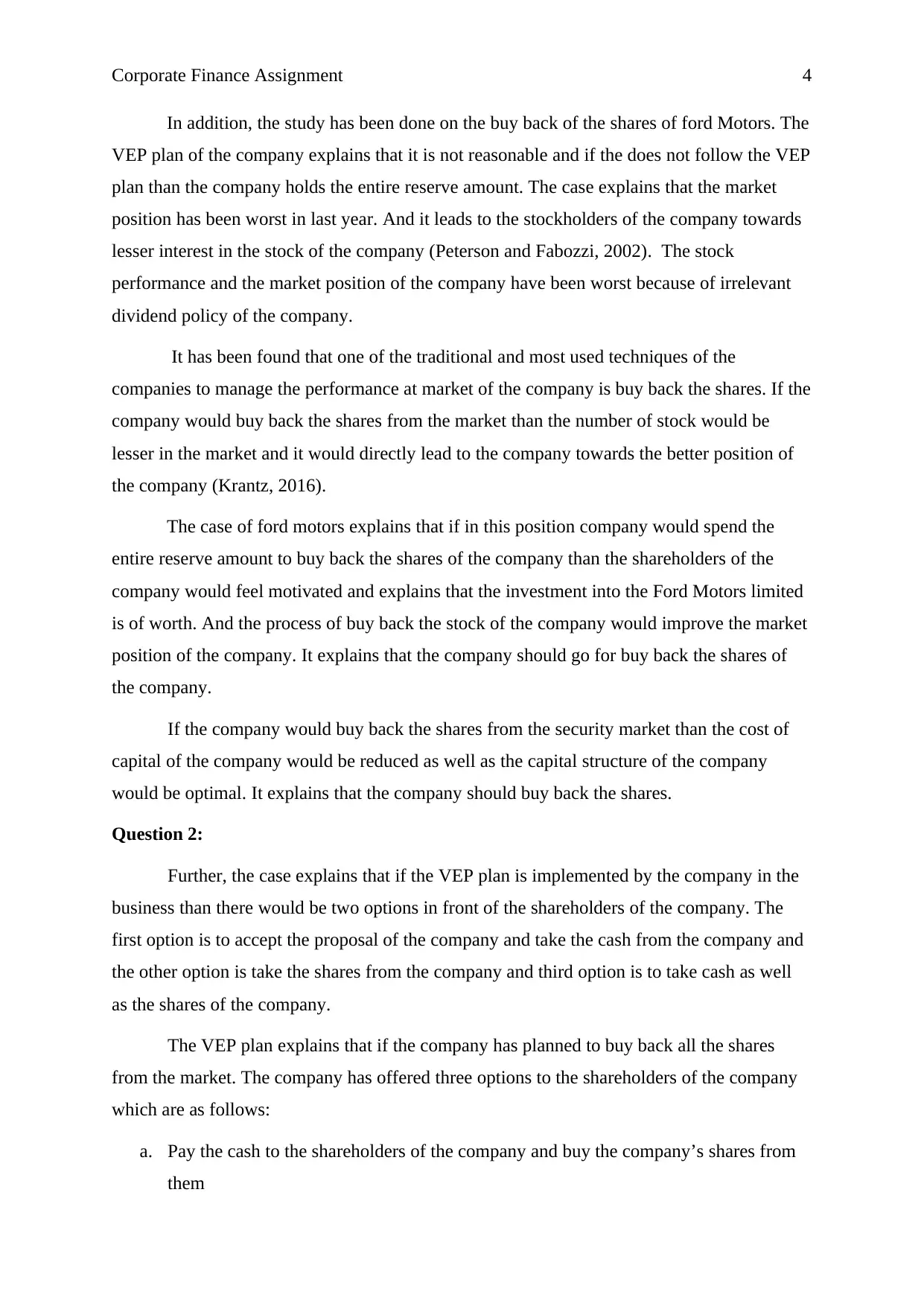
Corporate Finance Assignment 4
In addition, the study has been done on the buy back of the shares of ford Motors. The
VEP plan of the company explains that it is not reasonable and if the does not follow the VEP
plan than the company holds the entire reserve amount. The case explains that the market
position has been worst in last year. And it leads to the stockholders of the company towards
lesser interest in the stock of the company (Peterson and Fabozzi, 2002). The stock
performance and the market position of the company have been worst because of irrelevant
dividend policy of the company.
It has been found that one of the traditional and most used techniques of the
companies to manage the performance at market of the company is buy back the shares. If the
company would buy back the shares from the market than the number of stock would be
lesser in the market and it would directly lead to the company towards the better position of
the company (Krantz, 2016).
The case of ford motors explains that if in this position company would spend the
entire reserve amount to buy back the shares of the company than the shareholders of the
company would feel motivated and explains that the investment into the Ford Motors limited
is of worth. And the process of buy back the stock of the company would improve the market
position of the company. It explains that the company should go for buy back the shares of
the company.
If the company would buy back the shares from the security market than the cost of
capital of the company would be reduced as well as the capital structure of the company
would be optimal. It explains that the company should buy back the shares.
Question 2:
Further, the case explains that if the VEP plan is implemented by the company in the
business than there would be two options in front of the shareholders of the company. The
first option is to accept the proposal of the company and take the cash from the company and
the other option is take the shares from the company and third option is to take cash as well
as the shares of the company.
The VEP plan explains that if the company has planned to buy back all the shares
from the market. The company has offered three options to the shareholders of the company
which are as follows:
a. Pay the cash to the shareholders of the company and buy the company’s shares from
them
In addition, the study has been done on the buy back of the shares of ford Motors. The
VEP plan of the company explains that it is not reasonable and if the does not follow the VEP
plan than the company holds the entire reserve amount. The case explains that the market
position has been worst in last year. And it leads to the stockholders of the company towards
lesser interest in the stock of the company (Peterson and Fabozzi, 2002). The stock
performance and the market position of the company have been worst because of irrelevant
dividend policy of the company.
It has been found that one of the traditional and most used techniques of the
companies to manage the performance at market of the company is buy back the shares. If the
company would buy back the shares from the market than the number of stock would be
lesser in the market and it would directly lead to the company towards the better position of
the company (Krantz, 2016).
The case of ford motors explains that if in this position company would spend the
entire reserve amount to buy back the shares of the company than the shareholders of the
company would feel motivated and explains that the investment into the Ford Motors limited
is of worth. And the process of buy back the stock of the company would improve the market
position of the company. It explains that the company should go for buy back the shares of
the company.
If the company would buy back the shares from the security market than the cost of
capital of the company would be reduced as well as the capital structure of the company
would be optimal. It explains that the company should buy back the shares.
Question 2:
Further, the case explains that if the VEP plan is implemented by the company in the
business than there would be two options in front of the shareholders of the company. The
first option is to accept the proposal of the company and take the cash from the company and
the other option is take the shares from the company and third option is to take cash as well
as the shares of the company.
The VEP plan explains that if the company has planned to buy back all the shares
from the market. The company has offered three options to the shareholders of the company
which are as follows:
a. Pay the cash to the shareholders of the company and buy the company’s shares from
them
Paraphrase This Document
Need a fresh take? Get an instant paraphrase of this document with our AI Paraphraser
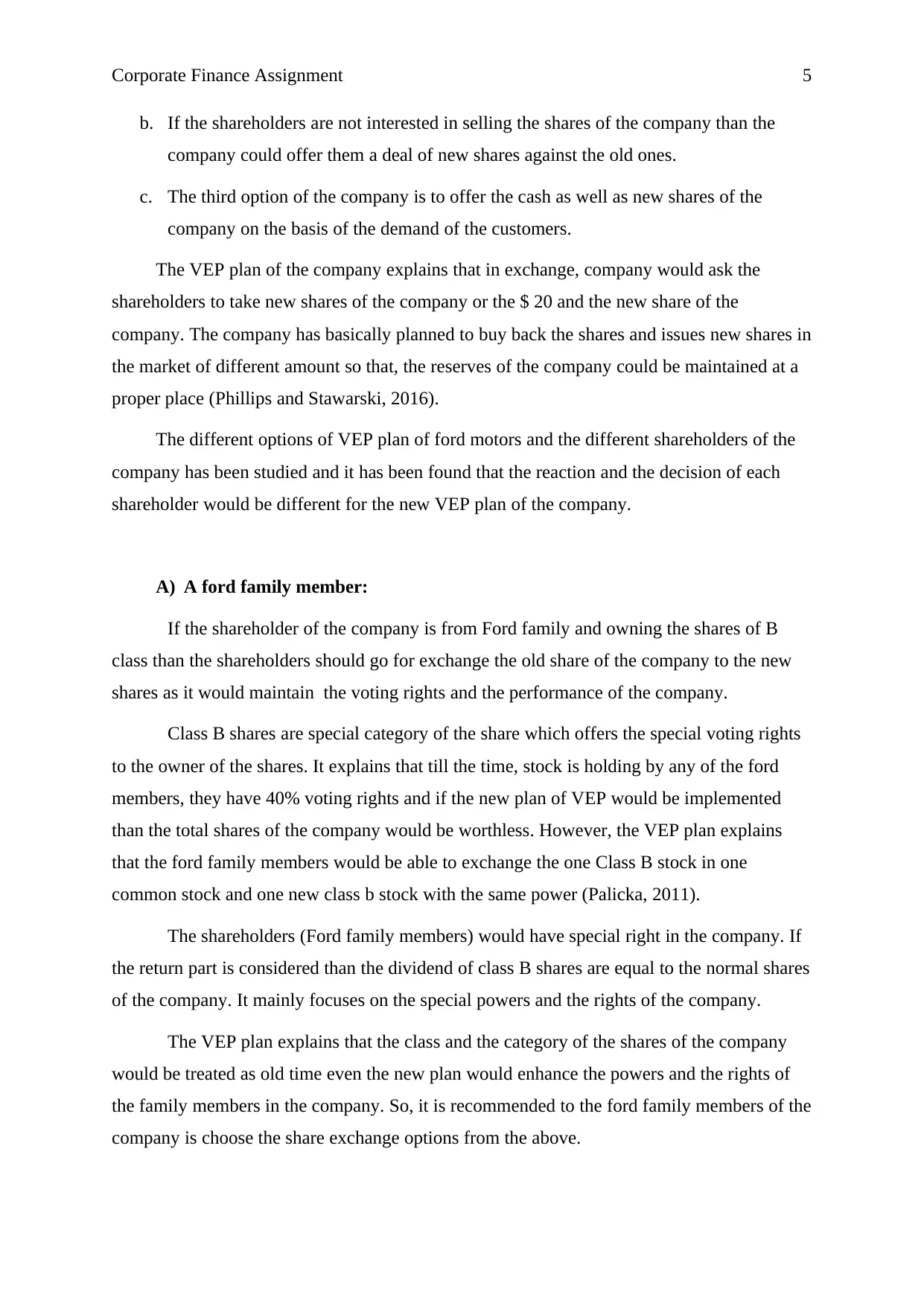
Corporate Finance Assignment 5
b. If the shareholders are not interested in selling the shares of the company than the
company could offer them a deal of new shares against the old ones.
c. The third option of the company is to offer the cash as well as new shares of the
company on the basis of the demand of the customers.
The VEP plan of the company explains that in exchange, company would ask the
shareholders to take new shares of the company or the $ 20 and the new share of the
company. The company has basically planned to buy back the shares and issues new shares in
the market of different amount so that, the reserves of the company could be maintained at a
proper place (Phillips and Stawarski, 2016).
The different options of VEP plan of ford motors and the different shareholders of the
company has been studied and it has been found that the reaction and the decision of each
shareholder would be different for the new VEP plan of the company.
A) A ford family member:
If the shareholder of the company is from Ford family and owning the shares of B
class than the shareholders should go for exchange the old share of the company to the new
shares as it would maintain the voting rights and the performance of the company.
Class B shares are special category of the share which offers the special voting rights
to the owner of the shares. It explains that till the time, stock is holding by any of the ford
members, they have 40% voting rights and if the new plan of VEP would be implemented
than the total shares of the company would be worthless. However, the VEP plan explains
that the ford family members would be able to exchange the one Class B stock in one
common stock and one new class b stock with the same power (Palicka, 2011).
The shareholders (Ford family members) would have special right in the company. If
the return part is considered than the dividend of class B shares are equal to the normal shares
of the company. It mainly focuses on the special powers and the rights of the company.
The VEP plan explains that the class and the category of the shares of the company
would be treated as old time even the new plan would enhance the powers and the rights of
the family members in the company. So, it is recommended to the ford family members of the
company is choose the share exchange options from the above.
b. If the shareholders are not interested in selling the shares of the company than the
company could offer them a deal of new shares against the old ones.
c. The third option of the company is to offer the cash as well as new shares of the
company on the basis of the demand of the customers.
The VEP plan of the company explains that in exchange, company would ask the
shareholders to take new shares of the company or the $ 20 and the new share of the
company. The company has basically planned to buy back the shares and issues new shares in
the market of different amount so that, the reserves of the company could be maintained at a
proper place (Phillips and Stawarski, 2016).
The different options of VEP plan of ford motors and the different shareholders of the
company has been studied and it has been found that the reaction and the decision of each
shareholder would be different for the new VEP plan of the company.
A) A ford family member:
If the shareholder of the company is from Ford family and owning the shares of B
class than the shareholders should go for exchange the old share of the company to the new
shares as it would maintain the voting rights and the performance of the company.
Class B shares are special category of the share which offers the special voting rights
to the owner of the shares. It explains that till the time, stock is holding by any of the ford
members, they have 40% voting rights and if the new plan of VEP would be implemented
than the total shares of the company would be worthless. However, the VEP plan explains
that the ford family members would be able to exchange the one Class B stock in one
common stock and one new class b stock with the same power (Palicka, 2011).
The shareholders (Ford family members) would have special right in the company. If
the return part is considered than the dividend of class B shares are equal to the normal shares
of the company. It mainly focuses on the special powers and the rights of the company.
The VEP plan explains that the class and the category of the shares of the company
would be treated as old time even the new plan would enhance the powers and the rights of
the family members in the company. So, it is recommended to the ford family members of the
company is choose the share exchange options from the above.
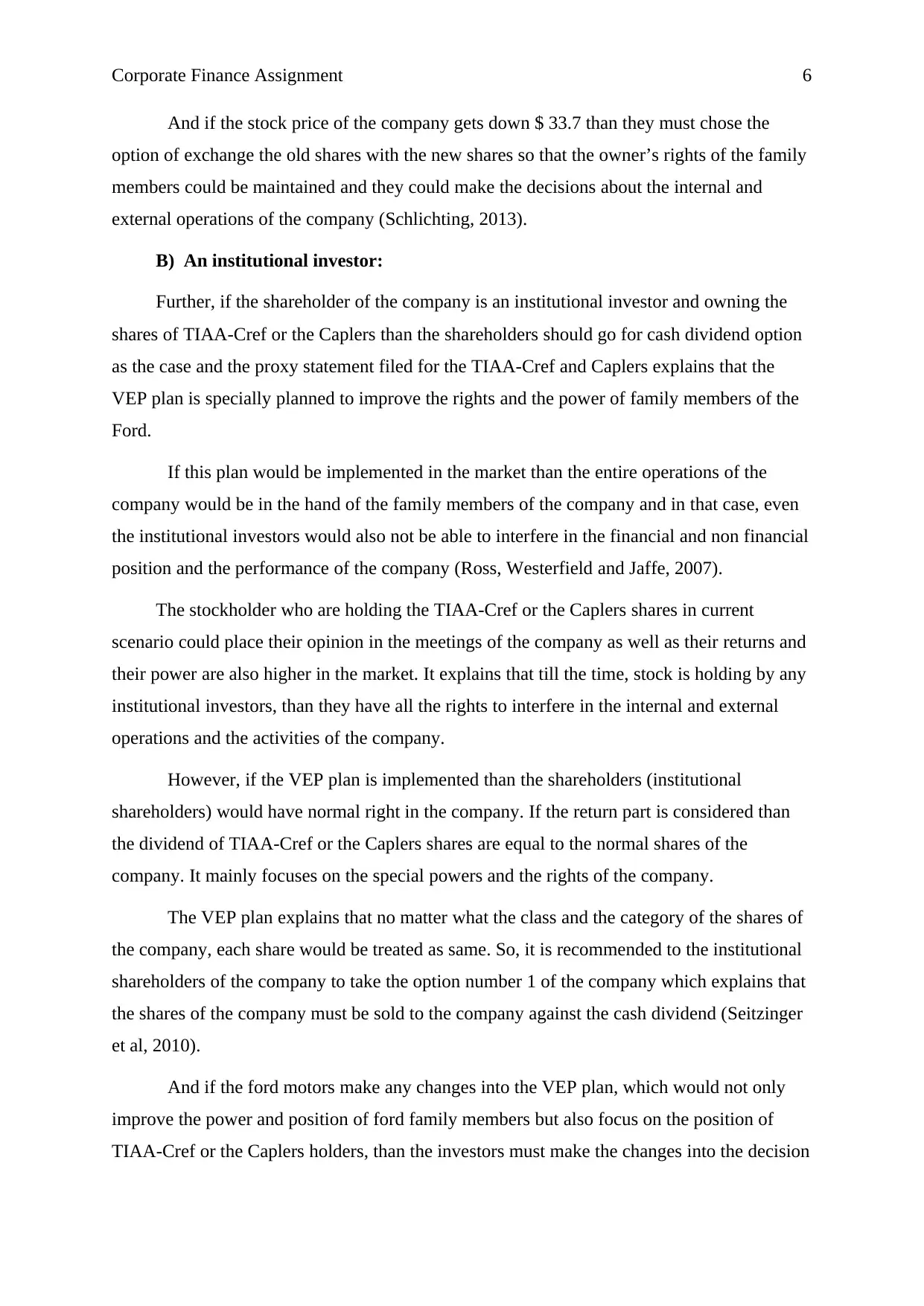
Corporate Finance Assignment 6
And if the stock price of the company gets down $ 33.7 than they must chose the
option of exchange the old shares with the new shares so that the owner’s rights of the family
members could be maintained and they could make the decisions about the internal and
external operations of the company (Schlichting, 2013).
B) An institutional investor:
Further, if the shareholder of the company is an institutional investor and owning the
shares of TIAA-Cref or the Caplers than the shareholders should go for cash dividend option
as the case and the proxy statement filed for the TIAA-Cref and Caplers explains that the
VEP plan is specially planned to improve the rights and the power of family members of the
Ford.
If this plan would be implemented in the market than the entire operations of the
company would be in the hand of the family members of the company and in that case, even
the institutional investors would also not be able to interfere in the financial and non financial
position and the performance of the company (Ross, Westerfield and Jaffe, 2007).
The stockholder who are holding the TIAA-Cref or the Caplers shares in current
scenario could place their opinion in the meetings of the company as well as their returns and
their power are also higher in the market. It explains that till the time, stock is holding by any
institutional investors, than they have all the rights to interfere in the internal and external
operations and the activities of the company.
However, if the VEP plan is implemented than the shareholders (institutional
shareholders) would have normal right in the company. If the return part is considered than
the dividend of TIAA-Cref or the Caplers shares are equal to the normal shares of the
company. It mainly focuses on the special powers and the rights of the company.
The VEP plan explains that no matter what the class and the category of the shares of
the company, each share would be treated as same. So, it is recommended to the institutional
shareholders of the company to take the option number 1 of the company which explains that
the shares of the company must be sold to the company against the cash dividend (Seitzinger
et al, 2010).
And if the ford motors make any changes into the VEP plan, which would not only
improve the power and position of ford family members but also focus on the position of
TIAA-Cref or the Caplers holders, than the investors must make the changes into the decision
And if the stock price of the company gets down $ 33.7 than they must chose the
option of exchange the old shares with the new shares so that the owner’s rights of the family
members could be maintained and they could make the decisions about the internal and
external operations of the company (Schlichting, 2013).
B) An institutional investor:
Further, if the shareholder of the company is an institutional investor and owning the
shares of TIAA-Cref or the Caplers than the shareholders should go for cash dividend option
as the case and the proxy statement filed for the TIAA-Cref and Caplers explains that the
VEP plan is specially planned to improve the rights and the power of family members of the
Ford.
If this plan would be implemented in the market than the entire operations of the
company would be in the hand of the family members of the company and in that case, even
the institutional investors would also not be able to interfere in the financial and non financial
position and the performance of the company (Ross, Westerfield and Jaffe, 2007).
The stockholder who are holding the TIAA-Cref or the Caplers shares in current
scenario could place their opinion in the meetings of the company as well as their returns and
their power are also higher in the market. It explains that till the time, stock is holding by any
institutional investors, than they have all the rights to interfere in the internal and external
operations and the activities of the company.
However, if the VEP plan is implemented than the shareholders (institutional
shareholders) would have normal right in the company. If the return part is considered than
the dividend of TIAA-Cref or the Caplers shares are equal to the normal shares of the
company. It mainly focuses on the special powers and the rights of the company.
The VEP plan explains that no matter what the class and the category of the shares of
the company, each share would be treated as same. So, it is recommended to the institutional
shareholders of the company to take the option number 1 of the company which explains that
the shares of the company must be sold to the company against the cash dividend (Seitzinger
et al, 2010).
And if the ford motors make any changes into the VEP plan, which would not only
improve the power and position of ford family members but also focus on the position of
TIAA-Cref or the Caplers holders, than the investors must make the changes into the decision
⊘ This is a preview!⊘
Do you want full access?
Subscribe today to unlock all pages.

Trusted by 1+ million students worldwide
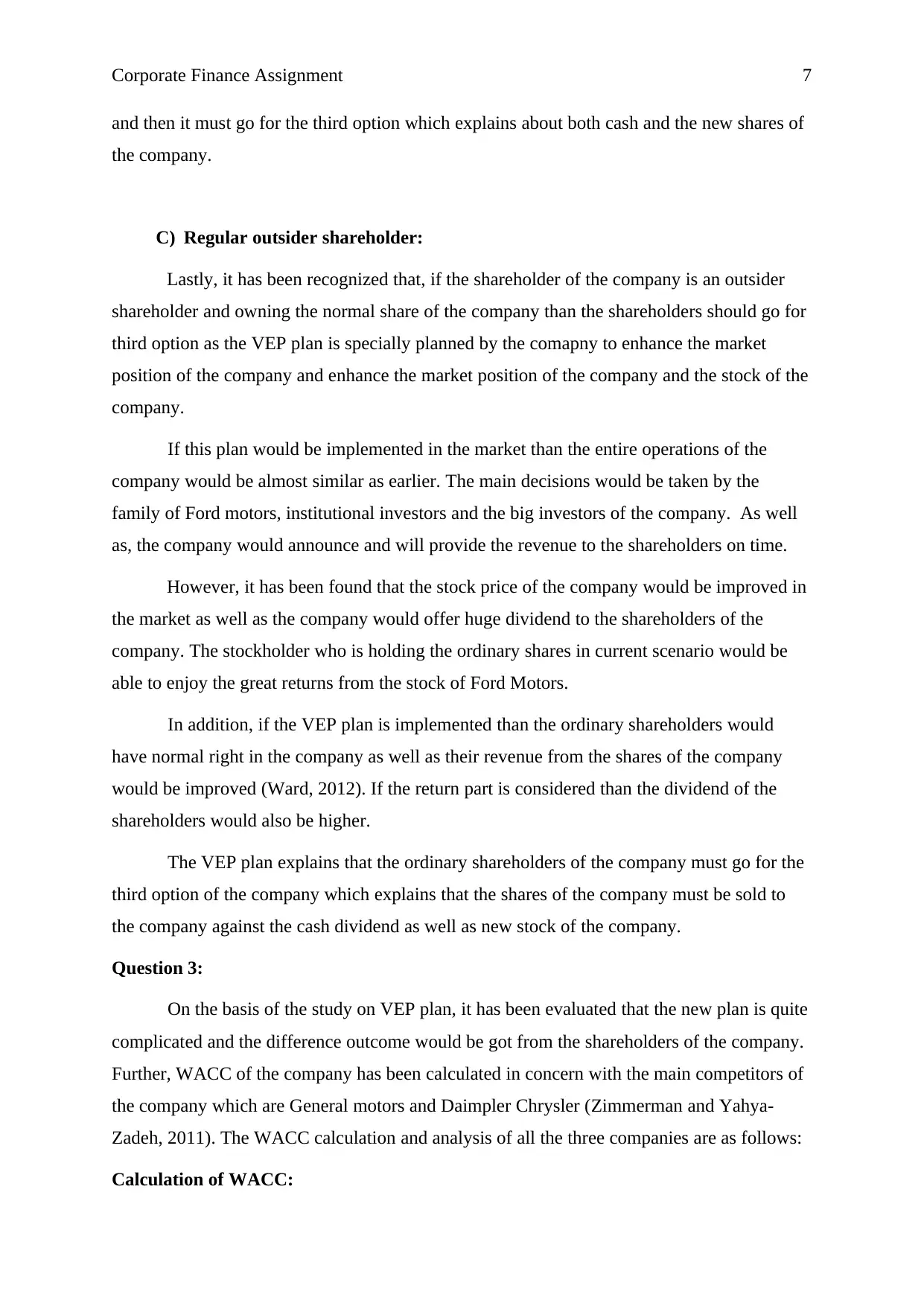
Corporate Finance Assignment 7
and then it must go for the third option which explains about both cash and the new shares of
the company.
C) Regular outsider shareholder:
Lastly, it has been recognized that, if the shareholder of the company is an outsider
shareholder and owning the normal share of the company than the shareholders should go for
third option as the VEP plan is specially planned by the comapny to enhance the market
position of the company and enhance the market position of the company and the stock of the
company.
If this plan would be implemented in the market than the entire operations of the
company would be almost similar as earlier. The main decisions would be taken by the
family of Ford motors, institutional investors and the big investors of the company. As well
as, the company would announce and will provide the revenue to the shareholders on time.
However, it has been found that the stock price of the company would be improved in
the market as well as the company would offer huge dividend to the shareholders of the
company. The stockholder who is holding the ordinary shares in current scenario would be
able to enjoy the great returns from the stock of Ford Motors.
In addition, if the VEP plan is implemented than the ordinary shareholders would
have normal right in the company as well as their revenue from the shares of the company
would be improved (Ward, 2012). If the return part is considered than the dividend of the
shareholders would also be higher.
The VEP plan explains that the ordinary shareholders of the company must go for the
third option of the company which explains that the shares of the company must be sold to
the company against the cash dividend as well as new stock of the company.
Question 3:
On the basis of the study on VEP plan, it has been evaluated that the new plan is quite
complicated and the difference outcome would be got from the shareholders of the company.
Further, WACC of the company has been calculated in concern with the main competitors of
the company which are General motors and Daimpler Chrysler (Zimmerman and Yahya-
Zadeh, 2011). The WACC calculation and analysis of all the three companies are as follows:
Calculation of WACC:
and then it must go for the third option which explains about both cash and the new shares of
the company.
C) Regular outsider shareholder:
Lastly, it has been recognized that, if the shareholder of the company is an outsider
shareholder and owning the normal share of the company than the shareholders should go for
third option as the VEP plan is specially planned by the comapny to enhance the market
position of the company and enhance the market position of the company and the stock of the
company.
If this plan would be implemented in the market than the entire operations of the
company would be almost similar as earlier. The main decisions would be taken by the
family of Ford motors, institutional investors and the big investors of the company. As well
as, the company would announce and will provide the revenue to the shareholders on time.
However, it has been found that the stock price of the company would be improved in
the market as well as the company would offer huge dividend to the shareholders of the
company. The stockholder who is holding the ordinary shares in current scenario would be
able to enjoy the great returns from the stock of Ford Motors.
In addition, if the VEP plan is implemented than the ordinary shareholders would
have normal right in the company as well as their revenue from the shares of the company
would be improved (Ward, 2012). If the return part is considered than the dividend of the
shareholders would also be higher.
The VEP plan explains that the ordinary shareholders of the company must go for the
third option of the company which explains that the shares of the company must be sold to
the company against the cash dividend as well as new stock of the company.
Question 3:
On the basis of the study on VEP plan, it has been evaluated that the new plan is quite
complicated and the difference outcome would be got from the shareholders of the company.
Further, WACC of the company has been calculated in concern with the main competitors of
the company which are General motors and Daimpler Chrysler (Zimmerman and Yahya-
Zadeh, 2011). The WACC calculation and analysis of all the three companies are as follows:
Calculation of WACC:
Paraphrase This Document
Need a fresh take? Get an instant paraphrase of this document with our AI Paraphraser
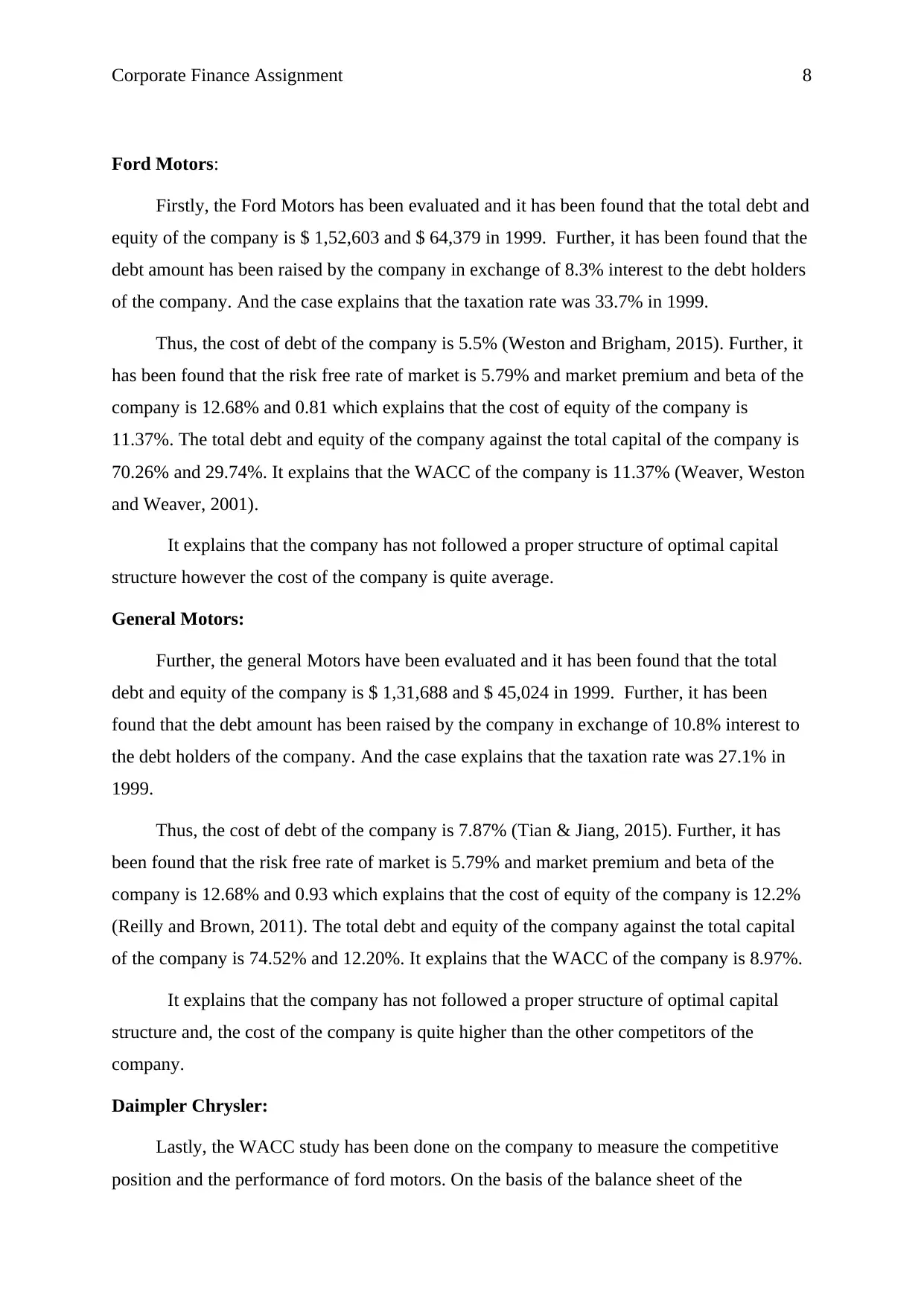
Corporate Finance Assignment 8
Ford Motors:
Firstly, the Ford Motors has been evaluated and it has been found that the total debt and
equity of the company is $ 1,52,603 and $ 64,379 in 1999. Further, it has been found that the
debt amount has been raised by the company in exchange of 8.3% interest to the debt holders
of the company. And the case explains that the taxation rate was 33.7% in 1999.
Thus, the cost of debt of the company is 5.5% (Weston and Brigham, 2015). Further, it
has been found that the risk free rate of market is 5.79% and market premium and beta of the
company is 12.68% and 0.81 which explains that the cost of equity of the company is
11.37%. The total debt and equity of the company against the total capital of the company is
70.26% and 29.74%. It explains that the WACC of the company is 11.37% (Weaver, Weston
and Weaver, 2001).
It explains that the company has not followed a proper structure of optimal capital
structure however the cost of the company is quite average.
General Motors:
Further, the general Motors have been evaluated and it has been found that the total
debt and equity of the company is $ 1,31,688 and $ 45,024 in 1999. Further, it has been
found that the debt amount has been raised by the company in exchange of 10.8% interest to
the debt holders of the company. And the case explains that the taxation rate was 27.1% in
1999.
Thus, the cost of debt of the company is 7.87% (Tian & Jiang, 2015). Further, it has
been found that the risk free rate of market is 5.79% and market premium and beta of the
company is 12.68% and 0.93 which explains that the cost of equity of the company is 12.2%
(Reilly and Brown, 2011). The total debt and equity of the company against the total capital
of the company is 74.52% and 12.20%. It explains that the WACC of the company is 8.97%.
It explains that the company has not followed a proper structure of optimal capital
structure and, the cost of the company is quite higher than the other competitors of the
company.
Daimpler Chrysler:
Lastly, the WACC study has been done on the company to measure the competitive
position and the performance of ford motors. On the basis of the balance sheet of the
Ford Motors:
Firstly, the Ford Motors has been evaluated and it has been found that the total debt and
equity of the company is $ 1,52,603 and $ 64,379 in 1999. Further, it has been found that the
debt amount has been raised by the company in exchange of 8.3% interest to the debt holders
of the company. And the case explains that the taxation rate was 33.7% in 1999.
Thus, the cost of debt of the company is 5.5% (Weston and Brigham, 2015). Further, it
has been found that the risk free rate of market is 5.79% and market premium and beta of the
company is 12.68% and 0.81 which explains that the cost of equity of the company is
11.37%. The total debt and equity of the company against the total capital of the company is
70.26% and 29.74%. It explains that the WACC of the company is 11.37% (Weaver, Weston
and Weaver, 2001).
It explains that the company has not followed a proper structure of optimal capital
structure however the cost of the company is quite average.
General Motors:
Further, the general Motors have been evaluated and it has been found that the total
debt and equity of the company is $ 1,31,688 and $ 45,024 in 1999. Further, it has been
found that the debt amount has been raised by the company in exchange of 10.8% interest to
the debt holders of the company. And the case explains that the taxation rate was 27.1% in
1999.
Thus, the cost of debt of the company is 7.87% (Tian & Jiang, 2015). Further, it has
been found that the risk free rate of market is 5.79% and market premium and beta of the
company is 12.68% and 0.93 which explains that the cost of equity of the company is 12.2%
(Reilly and Brown, 2011). The total debt and equity of the company against the total capital
of the company is 74.52% and 12.20%. It explains that the WACC of the company is 8.97%.
It explains that the company has not followed a proper structure of optimal capital
structure and, the cost of the company is quite higher than the other competitors of the
company.
Daimpler Chrysler:
Lastly, the WACC study has been done on the company to measure the competitive
position and the performance of ford motors. On the basis of the balance sheet of the
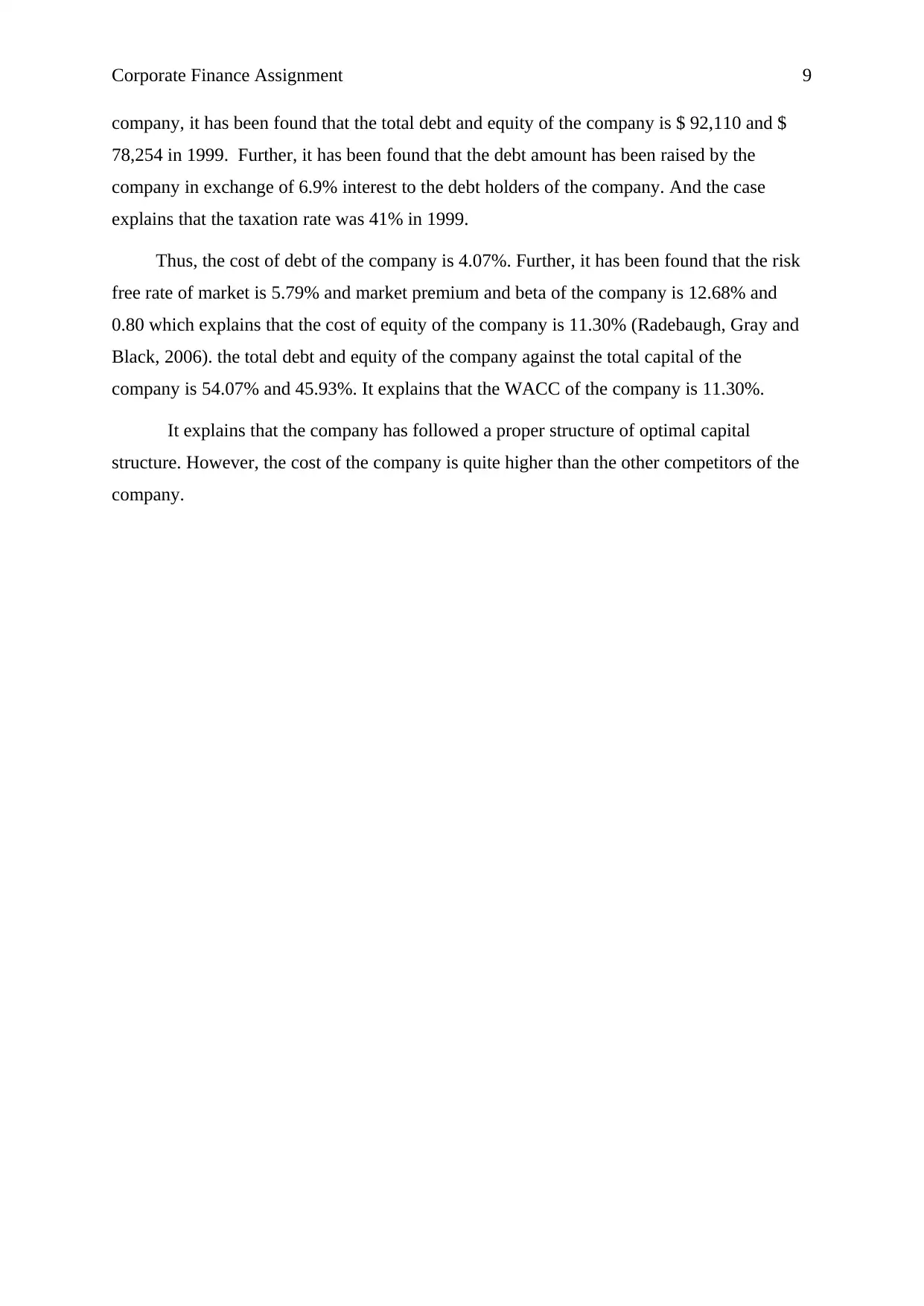
Corporate Finance Assignment 9
company, it has been found that the total debt and equity of the company is $ 92,110 and $
78,254 in 1999. Further, it has been found that the debt amount has been raised by the
company in exchange of 6.9% interest to the debt holders of the company. And the case
explains that the taxation rate was 41% in 1999.
Thus, the cost of debt of the company is 4.07%. Further, it has been found that the risk
free rate of market is 5.79% and market premium and beta of the company is 12.68% and
0.80 which explains that the cost of equity of the company is 11.30% (Radebaugh, Gray and
Black, 2006). the total debt and equity of the company against the total capital of the
company is 54.07% and 45.93%. It explains that the WACC of the company is 11.30%.
It explains that the company has followed a proper structure of optimal capital
structure. However, the cost of the company is quite higher than the other competitors of the
company.
company, it has been found that the total debt and equity of the company is $ 92,110 and $
78,254 in 1999. Further, it has been found that the debt amount has been raised by the
company in exchange of 6.9% interest to the debt holders of the company. And the case
explains that the taxation rate was 41% in 1999.
Thus, the cost of debt of the company is 4.07%. Further, it has been found that the risk
free rate of market is 5.79% and market premium and beta of the company is 12.68% and
0.80 which explains that the cost of equity of the company is 11.30% (Radebaugh, Gray and
Black, 2006). the total debt and equity of the company against the total capital of the
company is 54.07% and 45.93%. It explains that the WACC of the company is 11.30%.
It explains that the company has followed a proper structure of optimal capital
structure. However, the cost of the company is quite higher than the other competitors of the
company.
⊘ This is a preview!⊘
Do you want full access?
Subscribe today to unlock all pages.

Trusted by 1+ million students worldwide
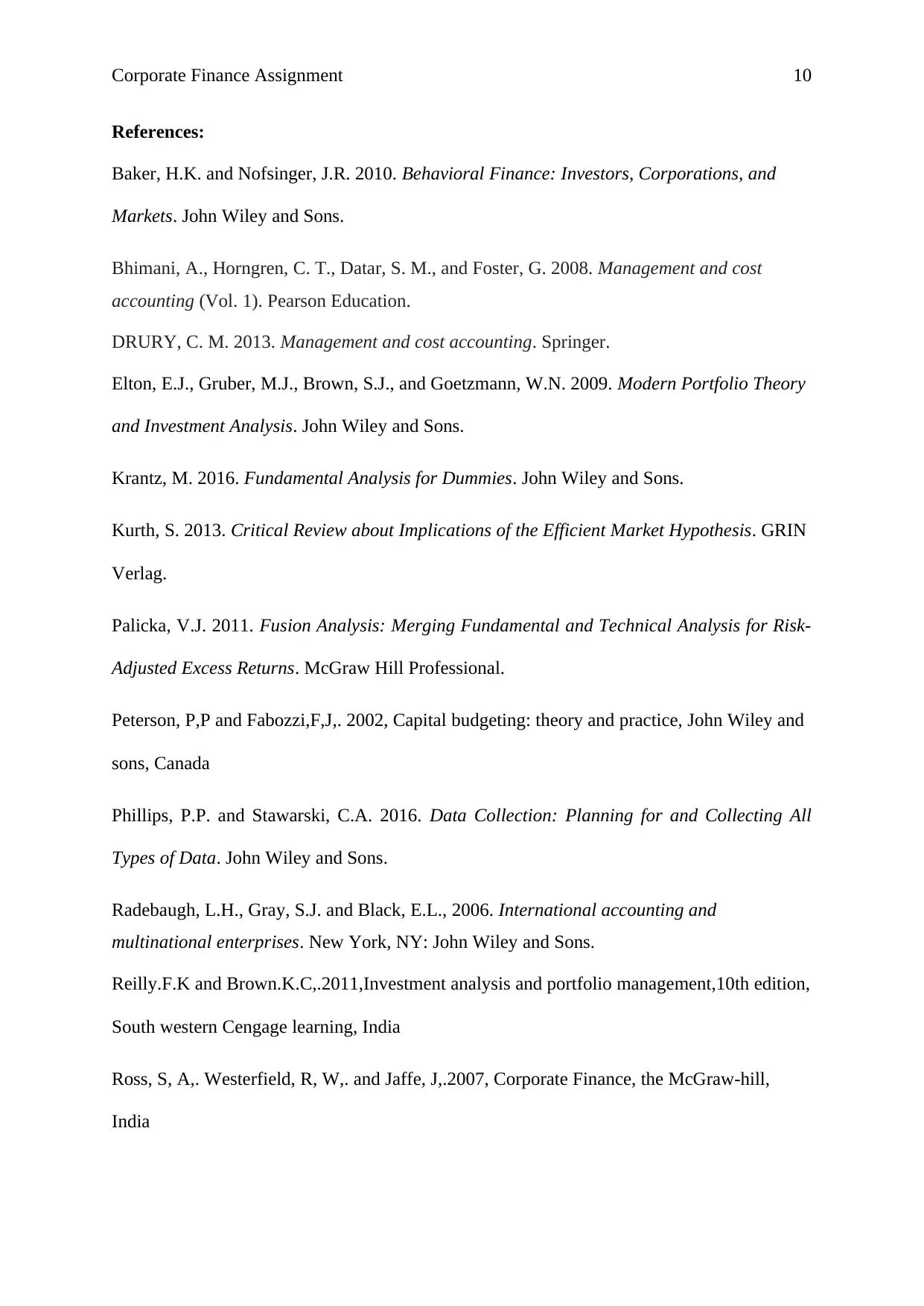
Corporate Finance Assignment 10
References:
Baker, H.K. and Nofsinger, J.R. 2010. Behavioral Finance: Investors, Corporations, and
Markets. John Wiley and Sons.
Bhimani, A., Horngren, C. T., Datar, S. M., and Foster, G. 2008. Management and cost
accounting (Vol. 1). Pearson Education.
DRURY, C. M. 2013. Management and cost accounting. Springer.
Elton, E.J., Gruber, M.J., Brown, S.J., and Goetzmann, W.N. 2009. Modern Portfolio Theory
and Investment Analysis. John Wiley and Sons.
Krantz, M. 2016. Fundamental Analysis for Dummies. John Wiley and Sons.
Kurth, S. 2013. Critical Review about Implications of the Efficient Market Hypothesis. GRIN
Verlag.
Palicka, V.J. 2011. Fusion Analysis: Merging Fundamental and Technical Analysis for Risk-
Adjusted Excess Returns. McGraw Hill Professional.
Peterson, P,P and Fabozzi,F,J,. 2002, Capital budgeting: theory and practice, John Wiley and
sons, Canada
Phillips, P.P. and Stawarski, C.A. 2016. Data Collection: Planning for and Collecting All
Types of Data. John Wiley and Sons.
Radebaugh, L.H., Gray, S.J. and Black, E.L., 2006. International accounting and
multinational enterprises. New York, NY: John Wiley and Sons.
Reilly.F.K and Brown.K.C,.2011,Investment analysis and portfolio management,10th edition,
South western Cengage learning, India
Ross, S, A,. Westerfield, R, W,. and Jaffe, J,.2007, Corporate Finance, the McGraw-hill,
India
References:
Baker, H.K. and Nofsinger, J.R. 2010. Behavioral Finance: Investors, Corporations, and
Markets. John Wiley and Sons.
Bhimani, A., Horngren, C. T., Datar, S. M., and Foster, G. 2008. Management and cost
accounting (Vol. 1). Pearson Education.
DRURY, C. M. 2013. Management and cost accounting. Springer.
Elton, E.J., Gruber, M.J., Brown, S.J., and Goetzmann, W.N. 2009. Modern Portfolio Theory
and Investment Analysis. John Wiley and Sons.
Krantz, M. 2016. Fundamental Analysis for Dummies. John Wiley and Sons.
Kurth, S. 2013. Critical Review about Implications of the Efficient Market Hypothesis. GRIN
Verlag.
Palicka, V.J. 2011. Fusion Analysis: Merging Fundamental and Technical Analysis for Risk-
Adjusted Excess Returns. McGraw Hill Professional.
Peterson, P,P and Fabozzi,F,J,. 2002, Capital budgeting: theory and practice, John Wiley and
sons, Canada
Phillips, P.P. and Stawarski, C.A. 2016. Data Collection: Planning for and Collecting All
Types of Data. John Wiley and Sons.
Radebaugh, L.H., Gray, S.J. and Black, E.L., 2006. International accounting and
multinational enterprises. New York, NY: John Wiley and Sons.
Reilly.F.K and Brown.K.C,.2011,Investment analysis and portfolio management,10th edition,
South western Cengage learning, India
Ross, S, A,. Westerfield, R, W,. and Jaffe, J,.2007, Corporate Finance, the McGraw-hill,
India
Paraphrase This Document
Need a fresh take? Get an instant paraphrase of this document with our AI Paraphraser
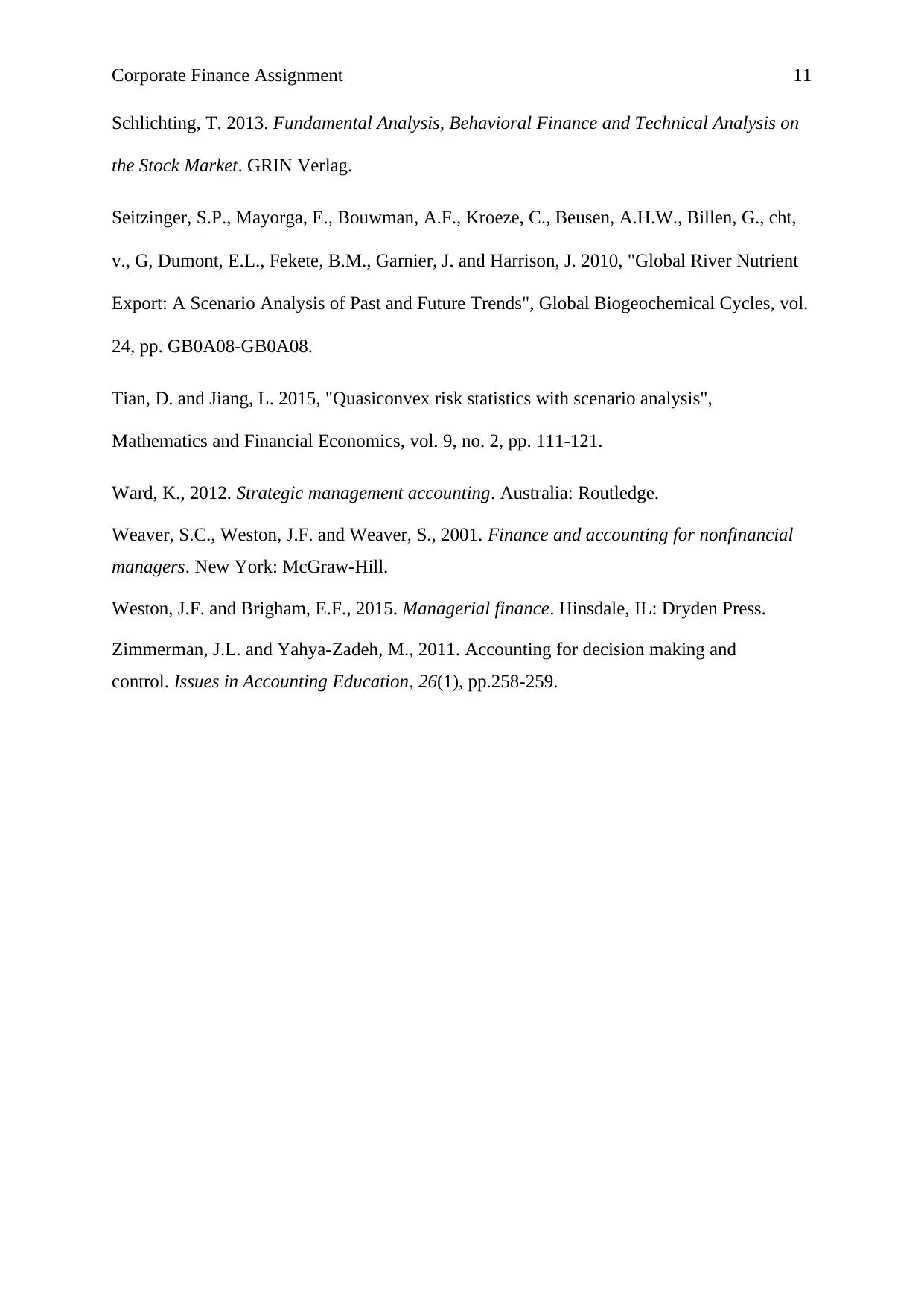
Corporate Finance Assignment 11
Schlichting, T. 2013. Fundamental Analysis, Behavioral Finance and Technical Analysis on
the Stock Market. GRIN Verlag.
Seitzinger, S.P., Mayorga, E., Bouwman, A.F., Kroeze, C., Beusen, A.H.W., Billen, G., cht,
v., G, Dumont, E.L., Fekete, B.M., Garnier, J. and Harrison, J. 2010, "Global River Nutrient
Export: A Scenario Analysis of Past and Future Trends", Global Biogeochemical Cycles, vol.
24, pp. GB0A08-GB0A08.
Tian, D. and Jiang, L. 2015, "Quasiconvex risk statistics with scenario analysis",
Mathematics and Financial Economics, vol. 9, no. 2, pp. 111-121.
Ward, K., 2012. Strategic management accounting. Australia: Routledge.
Weaver, S.C., Weston, J.F. and Weaver, S., 2001. Finance and accounting for nonfinancial
managers. New York: McGraw-Hill.
Weston, J.F. and Brigham, E.F., 2015. Managerial finance. Hinsdale, IL: Dryden Press.
Zimmerman, J.L. and Yahya-Zadeh, M., 2011. Accounting for decision making and
control. Issues in Accounting Education, 26(1), pp.258-259.
Schlichting, T. 2013. Fundamental Analysis, Behavioral Finance and Technical Analysis on
the Stock Market. GRIN Verlag.
Seitzinger, S.P., Mayorga, E., Bouwman, A.F., Kroeze, C., Beusen, A.H.W., Billen, G., cht,
v., G, Dumont, E.L., Fekete, B.M., Garnier, J. and Harrison, J. 2010, "Global River Nutrient
Export: A Scenario Analysis of Past and Future Trends", Global Biogeochemical Cycles, vol.
24, pp. GB0A08-GB0A08.
Tian, D. and Jiang, L. 2015, "Quasiconvex risk statistics with scenario analysis",
Mathematics and Financial Economics, vol. 9, no. 2, pp. 111-121.
Ward, K., 2012. Strategic management accounting. Australia: Routledge.
Weaver, S.C., Weston, J.F. and Weaver, S., 2001. Finance and accounting for nonfinancial
managers. New York: McGraw-Hill.
Weston, J.F. and Brigham, E.F., 2015. Managerial finance. Hinsdale, IL: Dryden Press.
Zimmerman, J.L. and Yahya-Zadeh, M., 2011. Accounting for decision making and
control. Issues in Accounting Education, 26(1), pp.258-259.
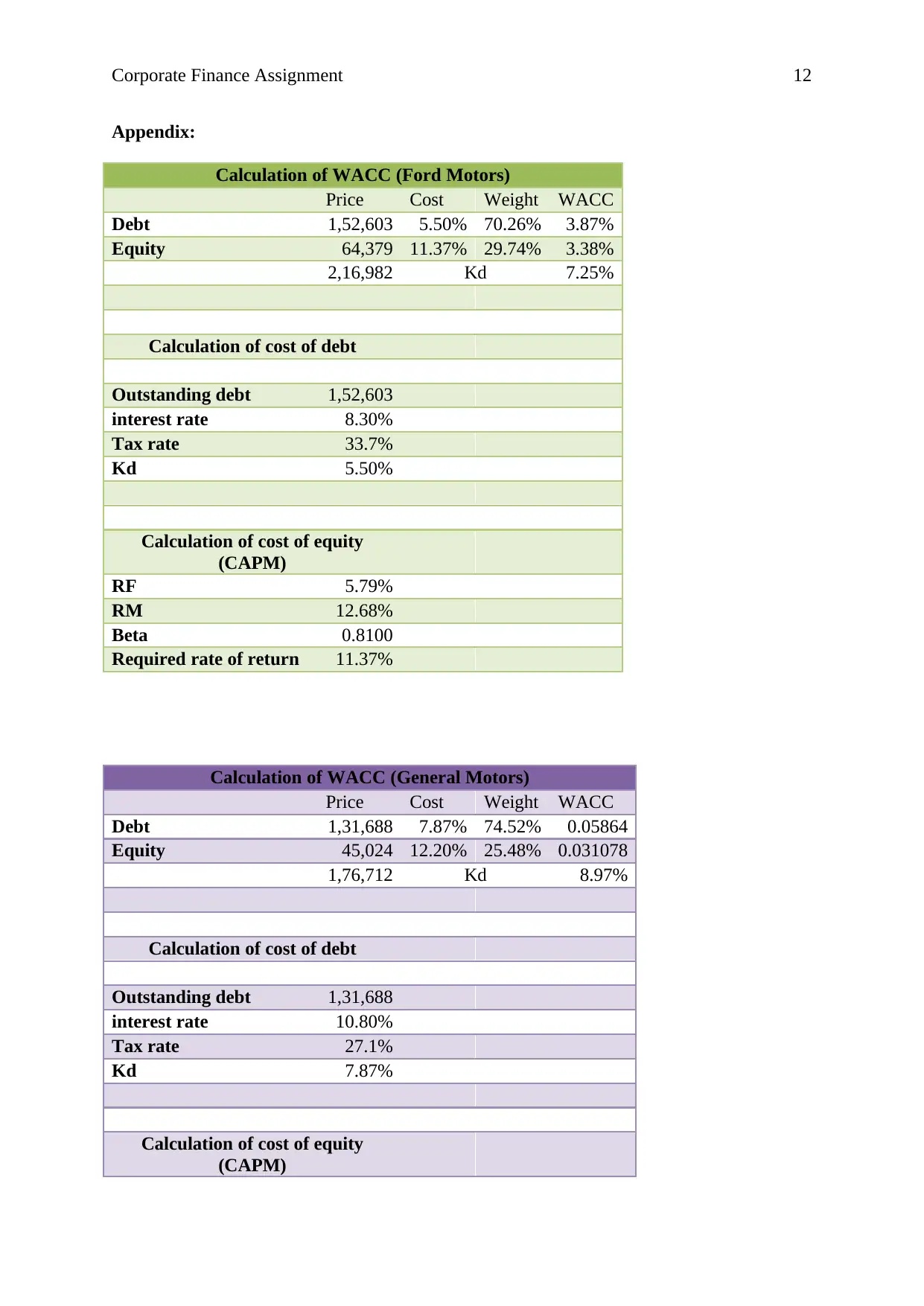
Corporate Finance Assignment 12
Appendix:
Calculation of WACC (Ford Motors)
Price Cost Weight WACC
Debt 1,52,603 5.50% 70.26% 3.87%
Equity 64,379 11.37% 29.74% 3.38%
2,16,982 Kd 7.25%
Calculation of cost of debt
Outstanding debt 1,52,603
interest rate 8.30%
Tax rate 33.7%
Kd 5.50%
Calculation of cost of equity
(CAPM)
RF 5.79%
RM 12.68%
Beta 0.8100
Required rate of return 11.37%
Calculation of WACC (General Motors)
Price Cost Weight WACC
Debt 1,31,688 7.87% 74.52% 0.05864
Equity 45,024 12.20% 25.48% 0.031078
1,76,712 Kd 8.97%
Calculation of cost of debt
Outstanding debt 1,31,688
interest rate 10.80%
Tax rate 27.1%
Kd 7.87%
Calculation of cost of equity
(CAPM)
Appendix:
Calculation of WACC (Ford Motors)
Price Cost Weight WACC
Debt 1,52,603 5.50% 70.26% 3.87%
Equity 64,379 11.37% 29.74% 3.38%
2,16,982 Kd 7.25%
Calculation of cost of debt
Outstanding debt 1,52,603
interest rate 8.30%
Tax rate 33.7%
Kd 5.50%
Calculation of cost of equity
(CAPM)
RF 5.79%
RM 12.68%
Beta 0.8100
Required rate of return 11.37%
Calculation of WACC (General Motors)
Price Cost Weight WACC
Debt 1,31,688 7.87% 74.52% 0.05864
Equity 45,024 12.20% 25.48% 0.031078
1,76,712 Kd 8.97%
Calculation of cost of debt
Outstanding debt 1,31,688
interest rate 10.80%
Tax rate 27.1%
Kd 7.87%
Calculation of cost of equity
(CAPM)
⊘ This is a preview!⊘
Do you want full access?
Subscribe today to unlock all pages.

Trusted by 1+ million students worldwide
1 out of 13
Related Documents
Your All-in-One AI-Powered Toolkit for Academic Success.
+13062052269
info@desklib.com
Available 24*7 on WhatsApp / Email
![[object Object]](/_next/static/media/star-bottom.7253800d.svg)
Unlock your academic potential
Copyright © 2020–2025 A2Z Services. All Rights Reserved. Developed and managed by ZUCOL.





